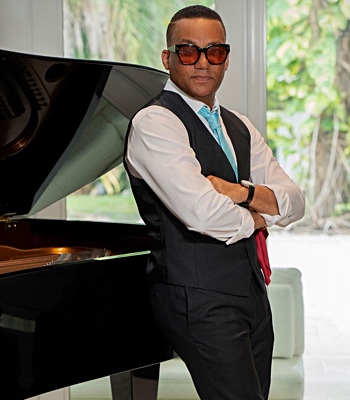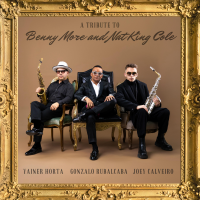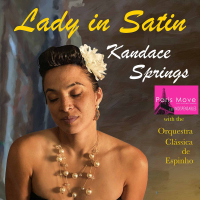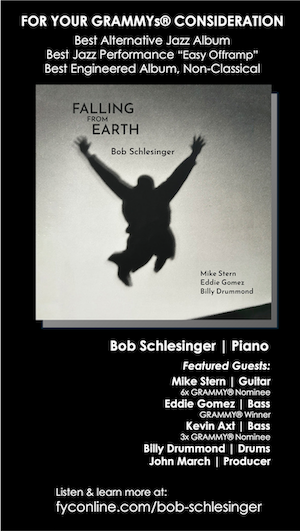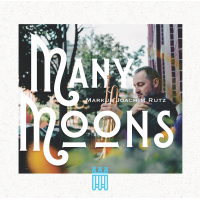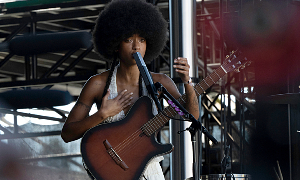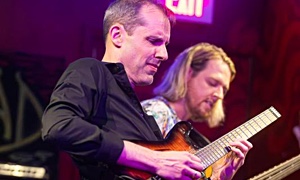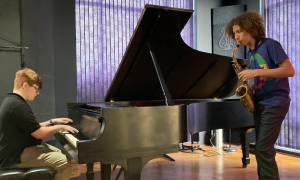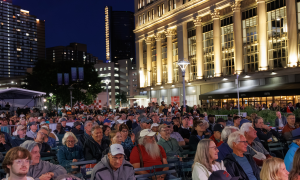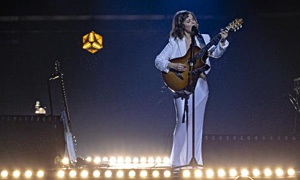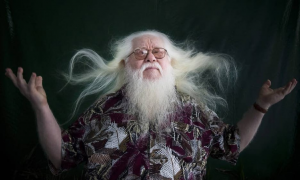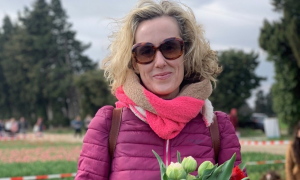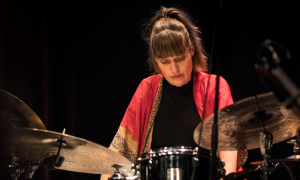Home » Jazz Articles » African Jazz » Day Two: 2005 Cape Town International Jazz Festival
Day Two: 2005 Cape Town International Jazz Festival
Cape Town
The city of Cape Town is located in the area where Portuguese navigators first made the open water connection between Atlantic and Indian Oceans over four hundred years ago. In subsequent development by the Dutch, it became an outpost for East-West trade routes, and it's still an important port for the region. All that international activity over the years meant that Cape Town would quickly become a cosmopolitan hub; among other things, it was the place where American sailors first introduced jazz to South Africa. Cape Town's still a haven for a distinctive west coast style of South African jazz. According to locals—and confirmed by my own observations—it's more laid back and open than the bustle and tumble of Johannesburg.You can still see first-hand evidence of the area's colonial beginnings if you visit the oldest building in the city, the five-pointed defensive fortress which also served as the early seat of government. The Castle of Good Hope, finished in 1679, has now been converted into a national monument. To get a cannon's eye view of the western part of the city, climb to the top of its walls, where six flags tell the story of European power, independence, and the eventual birth of the democratic Republic of South Africa in 1994. (Pictured above: the view south from the Castle of Good Hope: new and old buildings stand together in front of Signal Hill.)
You probably wouldn't know this unless someone told you, but Cape Town used to end at Strand St., where the beach originally began. In recent years the city has instituted an aggressive plan to reclaim land from the sea; the waterfront area is now home to hotels, the convention center (where the annual jazz festival is held), jazz clubs and restaurants, and vast shopping areas. All this development provides tourists and locals a place to frolic, but the rest of the city also offers plenty of opportunities and you'd do well to break free.
Cape Town's most prominent feature, right near the city center and visible from miles around, is the flat-topped, 1000m-high Table Mountain. Pictures don't really do this place justice, because it's just too enormous and dramatic to fit on a page. A short drive takes you to the visitors center, where a funicular rises steeply to the top. As you go up, the thing rotates a full turn, which can be a little disorienting if you don't expect it, but makes good sense since it offers everyone a full view of the landscape below.
Once you get to the top of Table Mountain (and yes, you can hike up there if you feel like a more rugged experience) you can stroll the flat part at the top, which offers dramatic and striking vistas all the way around, including Atlantic and Indian Oceans, the downtown area, Signal Hill, and Robben Island (the site of the famous prison which housed Nelson Mandela for many years and has now been converted into a museum). According to our guide, the plant diversity is greater than on the entire island of Britain. Other than a few birds here and there, the dassie is the animal you're most likely to encounter. These small mammals are not at all afraid of people, probably because they know there's a pretty good chance you'll break the rules and offer them a snack.
Our guide, Ebrahim, was eager to explain the history and place things in perspective. He offered a personal account of District Six, a multicultural community which was declared a "whites—only area" by the government in 1965 and subsequently bulldozed to physically remove all traces of blacks and colored people. Ebrahim used to live there and has faint childhood memories of his home turning into rubble. Interestingly, all the wreckage was dumped into the sea in the area where the shopping center was recently built. Apparently many older veterans of District Six aren't too keen to go shopping there, which actually makes a lot of sense when you think about it. Go to the museum to learn more.
The people of South Africa have been through a lot over the years, and they deserve a lot of credit for being open and honest about it. Looking back on apartheid legacies like passbooks (which every black worker had to carry and surrender to police for inspection) and the "pencil test" (by which authorities would determine your racial status by sticking a pencil in your hair and then seeing if it fell free when you shook your head), it's almost impossible to believe that South Africans could have endured such constant humiliation. But it was very much real; people remember it; and they're proud to have given birth to an open democracy that celebrates diversity.
The Western Cape province where Cape Town is located has three official languages: English, Afrikaans, and Xhosa. Students start school early in their mother tongue, then learn the other two down the road. We learned that the proper pronunciation of the word "Xhosa" involves a sharp tongue click in front of the "h," and with some assistance and a bit of practice, most of the American group was able to get somewhere close to saying it right. There are a few different ways of clicking, actually. Once you wrap your head around these clicks, you find yourself doing them at the oddest times. Eventually mischief kicked in, and someone suggested that maybe we should go back to the "[click!]hotel" if anyone was "[click!]hungry." Even the locals had to laugh.
Cape Town Jazz Festival, Day Two
Things seemed to pick up speed on Sunday March 27, the second and final day of the Cape Town International Jazz Festival. Headliners Dave Holland, Cesaria Evora, and the Commodores attracted particularly large audiences, but a variety of other alternatives (many previously unknown to me) helped keep up the diversity that has made the Cape Town jazz fest a singular attraction. A light rain moistened the air but didn't cause trouble along the way.Suthukazi Arosi
It was African diva night at Kippie's Stage, and South Africa's own Suthukazi Arosi was first up. Not a lot of people made it to her show, probably more a reflection of the early hour (5pm) than her overall popularity here. Arosi likes to be known as a sort of renaissance artist—dancer, model, actor, and musician—and while I'm not familiar with her work in the other roles, she definitely brings a flair for drama, poses, and motion to the musical stage. (Especially when cameras are near, not surprisingly.)Arosi's latest record, The Journey, placed her powerful voice in the hands of producer D-Rex for a polished set of moving, emotionally connected jams. I was curious to see whether she could make the studio act work in live performance; she brought back the magic, sure enough.
The backing musicians provided the necessary lush foundations but didn't intrude upon center stage, offering deference to the star of the show. But guitarist Phumelele Dolosi had an occasional sharp edge, relatively rare in a mostly smooth South African guitar world, which helped push the energy up a notch or two at key moments.
There's little compromise about Suthukazi Arosi's music, and its striking spiritual intensity—centered, of course, around her own piercing voice—has a glowing, magnetic quality. With her hyper-confident delivery, she's all about entry, sustain, and climax, but within a loosely rhythmic, gospel-influenced context it feels flowing and natural.
On stage, Arosi takes up a lot of space but doesn't waste energy with hyperkinetic motion. Posing with a big round black bowl (whose special significance I was unable to ascertain), she arched her neck and lifted her leg, then stepped away and twisted in a different direction. If you consider these moves dance, it's more interpretive and modern than the usual rhythmic sort. Still, not knowing what the singer would do next, you couldn't help but pay close attention.
Unfortunately the techies really screwed up the sound. Anyone who appreciates what Suthukazi Arosi does should know that she's got a piercing enough voice to get the point across without boosted treble and eardrum-splitting volume. After a few minutes it became clear that I was going to sustain hearing damage if I didn't do something about the situation, so I tore a ten-rand note in half in order to crumple up the pieces and create makeshift earplugs.
Cesaria Evora
To look at Cape Verde's "barefoot diva," Cesaria Evora, you wouldn't guess she would draw stadium crowds. The 64-year-old matron doesn't dance much, doesn't strike any poses, and doesn't shoot visual sparks in any particular direction. Standing on stage, she simply holds the microphone and sings, pausing to look around and occasionally smile.But thousands of people turned out to see her perform at Kippie's Stage, knocking me out of my usual front row position and relegating me to a spot somewhere in the middle. Evora draws crowds because of her romantic, softspoken music—and most of all, her liquid, velvety voice. She's become a megastar in world music for all the right reasons, really: talent and humility. She may not offer much flash and bang, but she owns the hearts of her fans and they're quite willing to surrender.
Evora's acoustic band included strings (guitar-like instruments and violin), piano, saxophone, and ample percussion. They played a few romantic minutes alone by way of introduction before the singer walked on stage, then joined in an hour of shared celebration. The lilting sway of her music rides on rhythms you don't usually hear in American or European music, but never in an overstated way. They're sufficient to make hips and shoulders sway, and sometimes that's enough. Certainly for this crowd. Minds and hearts, too, no doubt about that.
Bobo Stenson Trio
Since Rosie's Stage has a tendency to get crowded (and according to reports, even members of the press were being turned away from the best-selling events of the evening), I headed over there early to get a good seat for the Bobo Stenson Trio. A couple of photographers next to me in the front row had, by the smell of them, partaken quite freely from a mysterious source of free beer that I was unable to locate. The guy next to me, working for Reuters, admitted that he only had to get two good shots for the evening and was pretty well set already."So, who is this guy Bobo Stenson?" he asked. Thinking naively that he wanted some background, I said he was from Sweden and started describing the music, only to be interrupted by another question.
"But does Bobo really exist?" Ummm, so they say. What do you think?
"I heard he was one of those Scandiwegian guys." Resigned: yep.
"Let's see if this guy can actually do the piano. What am I here for?" Dude, you've got to point your camera at this guy and shoot some pictures. Do you think you can handle that?
"Oh yeah, right. But does Bobo Stenson exist? Bo-bo, bo-bo. Is he real?" And so on.
Six hours straight of unremitting jazz and people get a little loopy, I guess. My photographer friend straightened up and dutifully kneeled in front of the stage when the trio came forth, finally free of any doubts that the performer was in fact a real live human, not a figment of his well-lubricated imagination.
But having heard that up-and-coming South African star Simphiwe Dana had agreed to a second, outdoor midnight performance—after her scheduled show at the Moses Molelekwa stage got so crowded that hundreds of people were denied entrance—he quietly left after a few minutes to capture the action elsewhere. "This one is going to be big. I mean, she already is, but wait ten or fifteen years and you'll see," he warned me in advance. I was content to wait ten or fifteen seconds and enjoy some comparatively old-farty piano jazz. No regrets, either.
As Stenson himself put it when he introduced the band, this was indeed modern, creative jazz. The bassist and drummer who joined him on stage were Christian Spering and Jon Falt, respectively. The advertised Anders Jormin apparently couldn't make it, but Spering is a more than capable player who's worked with Stenson enough to speak his language quite fluently. It was an interesting collection of personalities: Stenson, low-key and quiet, content to be swept up in accumulating landscapes of sound; Spering, grounded and straightforward, finding common ground in unexpected places; and Falt, an attention-deficit mischief-maker restlessly shifting around his kit.
One thing that doesn't come across very well on Stenson's recordings is his sense of humor, which in a very Swedish way is clever and ironic but not particularly flashy. While they were clearly playing compositions (Russian, Swedish, and American), they constantly looked for opportunities to engage in musical conversation. By responding in real time to each other's musical gestures, they got the audience swept up guessing who would reply with a quote or an interjection. Falt spent a lot of time helping build atmospheric textures with brushes and bare hands, but he really came alive when he picked up his sticks and kicked in with quick, staccato phrases.
And while Stenson's music often has a meditative, pretty, chamber music water-mirror quality, it's also characterized by periods of light and dark, episodes of sharp intensity, and understated references to blues and gospel. The encore, which Stenson simply said was a goodbye, contained a strong blues feeling within a singable melody and seemed to focus around resolution of light tension. Just about the perfect midnight ending to a night packed with energy, and the audience agreed. Two standing ovations later, the Scandiwegians left the stage.
Tags
Comments
PREVIOUS / NEXT
Support All About Jazz
 All About Jazz has been a pillar of jazz since 1995, championing it as an art form and, more importantly, supporting the musicians who make it. Our enduring commitment has made "AAJ" one of the most culturally important websites of its kind, read by hundreds of thousands of fans, musicians and industry figures every month.
All About Jazz has been a pillar of jazz since 1995, championing it as an art form and, more importantly, supporting the musicians who make it. Our enduring commitment has made "AAJ" one of the most culturally important websites of its kind, read by hundreds of thousands of fans, musicians and industry figures every month.



